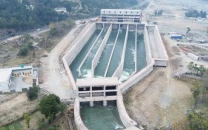CPEC, Pakistan and global value chains
Infrastructure in Pakistan is getting a major boost and now there is a need to make use of this opportunity

The writer is a public policy expert and an honorary Fellow of Consortium for Development Policy Research.
He tweets @hasaankhawar
So how did China do this? One of the key contributors was China’s leapfrogging on its industrialisation path through participation in global value chains (GVCs). A similar approach may also help Pakistan in defining industrial cooperation under CPEC.
But first it’s important to understand what these GVCs are. With increased globalisation, corporations are outsourcing their production processes more than ever before to locations where they can find best value for money. As a result, an iPhone may be designed in the US but gets its electronic chips from Taiwan, display from South Korea, cameras from Japan and finally gets assembled in China and Brazil before being sold across the globe. These are the so-called global value chains.
While GVCs are helping the multinational corporations to reduce their costs and improve the quality of their products, they are also enabling the participating countries to integrate into global markets without developing the knowhow of the full value chain. GVCs rest on detailed exchange of information, technology and components and deep supplier relationships much beyond the traditional knowledge transfers of the past.
For instance, Toyota is known for improving production systems of its suppliers, invest in their technical capabilities and undertake joint improvement activities, while rewarding them for good performance through orders for more components. Consequently, the offshore companies participating in GVCs acquire new technologies and skills resulting in improved processes, upgrading the product offering or even acquiring new functions altogether.
These could then have spillover effects for other firms in the country, enabling developing economies to move up the technology ladder from exporting raw materials to greater value addition and increased sophistication. Economists argue that such an approach enables countries with lower wages to industrialise much more rapidly than was previously possible.
This is exemplified by China’s experience, which successfully used its low-cost labour to partner with leading international corporations, selling to consumers around the world and in the process improved its own technological base and economic sophistication and becoming the world’s largest exporter.
In 2016, Pakistan’s overall trade was merely 25% of its GDP, as compared to the world’s average of 56%, South Asian average of 39%, 40% for India and 38% for Bangladesh. Looking at Pakistan’s export composition by production stage, raw material exports claimed 9% share in total exports in 2016, whereas intermediate goods claimed only 27%. The rest of 60% went to consumer products and a meagre 3% to capital goods. Although specific GVC participation data is not available for Pakistan, the trade-to-GDP ratio and current export composition depict low levels of trade openness and globalisation, resulting in low GVC participation.
Let’s look at the case of Pakistan’s auto parts industry. The car manufacturing industry is universally structured across GVCs, where automakers rely on a vast network of suppliers. The ‘Tier 1’ suppliers themselves are typically massive firms with global presence, such as Denso and Saint Gobin, with hundreds of thousands of employees, thousands of registered patents and operations across various countries. A recent research study undertaken by IDEAS highlight that Pakistani auto part manufactures, despite having significant exports, still lie on the periphery of this vast GVC, being secondary contractors to these Tier 1 suppliers.
So how can Pakistan increase its GVC participation and benefit from CPEC? Literature shows that primary drivers of GVC participation of a country include its market size, overall development, industrial structure and location. Pakistan scores quite well in terms of market size being the world’s fifth-largest country and also in terms of location, being next door neighbour to China, which is the world’s largest exporter, biggest production hub and one of the largest markets. CPEC is expected to further improve connectivity with China, enhancing this advantage. Accessing even part of the value chain of Chinese products presents a large opportunity for Pakistani manufacturers.
More importantly, however, certain policy levers can play an instrumental role in encouraging GVC participation. These include targeted trade policy, openness to the FDI, low cost to import, efficient trade and logistics infrastructure and facilitation, intellectual property protection and a friendly business environment.
While it may be difficult to immediately remove distortions in all these areas, the planned Special Economic Zones under CPEC can play a great role to create a micro-investment climate enabling GVC participation for local firms, supported through targeted investment policies.
The starting point should be integration with regional value chains, where Pakistan can benefit from lower costs of physical transportation. South Asia is one of the least integrated regions within Asia (Asian Development Bank’s Asian Economic Integration Report 2017) with inadequate infrastructure as a major constraint. With CPEC, however, this can change. The infrastructure in Pakistan is getting a major boost and now there is a need to make use of this opportunity to move towards greater economic integration and trade, not only across north-south corridor but also gradually moving east and west by better economic and trade ties with India and Iran.
Published in The Express Tribune, March 28th, 2018.
Like Opinion & Editorial on Facebook, follow @ETOpEd on Twitter to receive all updates on all our daily pieces.













COMMENTS
Comments are moderated and generally will be posted if they are on-topic and not abusive.
For more information, please see our Comments FAQ